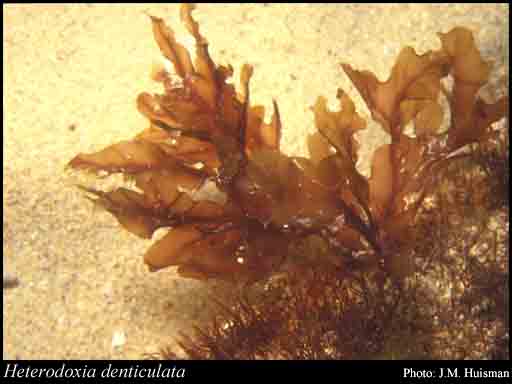- Reference
- Spec.Gen.Ord.Alg. 131 (1898)
- Conservation Code
- Not threatened
- Naturalised Status
- Native to Western Australia
- Name Status
- Current

Scientific Description
Habit and structure. Thallus medium red to dark red-brown, (5–)10–20 cm high, complanately and alternately marginally branched with well-developed midribs, branches 3–8 mm broad with delicate, slightly ruffled, wings with finely and irregularly dentate margins; wings lost below leaving a branched, subterete to compressed stipe 1–3 mm thick developed from the midrib. Holdfast fibrous, much branched, 5–15 mm across; epilithic. Structure. Growth by means of an obconical apical cell segmenting to give axial cells and within 1 or 2 segments lateral and transverse pericentral cells, the lateral pericentral cells forming second-order rows with the cells cutting off adaxial and abaxial cells or rows which develop rapidly to form a blade which overarches the apical cell; some marginal cells develop further to form the irregular, simple or branched, slender dentations. Cortication of the midrib commences early, becoming many cells thick with anticlinal rows of small isodiametric cells 12–18 µm in diameter, overlying the central layer of larger cells 40–60 µm across; blades at first monostromatic but cortication also commencing early, becoming 3 cells thick generally and 5 cells thick near the midribs (primary cells angular, 20–35 µm across), with the inner cortical cells dimidiate, then outer layers equivalent, regularly arranged. Branching occurs by apical cells developing on the blade margins. Mature cells multinucleate; rhodoplasts discoid.
Reproduction. Gametophytes dioecious. Procarps scattered, often densely, over young blades or leaflets, usually opposite on both sides, with a 4-celled carpogonial branch and probably 2 sterile groups. Carposporophytes with a basal, often 2-armed, fusion cell with branched gonimoblast filaments bearing chains of ovoid carposporangia 15–20 µm in diameter, maturing sequentially. Cystocarps scattered, few to several per blade, sunken within the blade and convex to hemispherical above, 1.5–2.5 mm across, ostiolate; pericarp thick, of anticlinal rows 10–15 cells long. Spermatangial sori on both sides of the midrib and the blade or on small leaflets, with several initials by division of the outer cortical cells, each producing 2–4 spermatangia. Tetrasporangial sori scattered on blades or on small leaflets arising from the midribs, 120–180 µm thick at sori, with tetrasporangia cut off from inner cortical cells on both sides of the blade, with outer cortical cells in anticlinal rows of 2–5 cells; tetrasporangia subspherical, 45–65 µm in diameter.
Distribution. Houtman Abrolhos, W. Aust., to Nora Creina, S. Aust.
[After Womersley, Mar. Benthic Fl. Southern Australia IIID: 69–71 (2003)]
Distribution
- IBRA Regions
- Geraldton Sandplains, Swan Coastal Plain.
- IBRA Subregions
- Geraldton Hills, Perth.
- IMCRA Regions
- Abrolhos Islands, Central West Coast, Leeuwin-Naturaliste.
- Local Government Areas (LGAs)
- Cambridge, Cockburn, Dandaragan, Greater Geraldton, Irwin, Joondalup, Rockingham, Wanneroo.